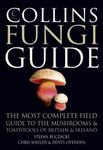Customer Reviews:
Collins Field Guides: Birds of North America
by Keith Betton in the United Kingdom (24/01/2012)
This book attempts to illustrate every species that has been found in North America and Greenland, and so the task is to fit over 900 species into a book so small that I have yet to find a coat pocket into which it won't fit. If you are familiar with Norman Arlott's recent works on the Palearctic and West Indies, you'll know the size I mean. That's some task! However it has been achieved – but sadly at the expense of both detail and usefulness.
I'll start by saying what I do quite like – and that is Arlott's paintings. They are simple, bright and fairly appealing. Secondly, if you know someone who needs all of these illustrations (there must be 1500 at least) in one concise volume, then this is the book for them. But there are already many excellent North American field guides and this book simply does not add any value.
The layout is of text facing illustrations and 10-15 species are dealt with on each double-page spread. The text is minimal, with brief field notes designed to give you a few hints on appearance and behaviour, plus voice, habitat and distribution. Both English and American names are given in that order (e.g. Little Auk / Dovekie) although you'd think in this book the local name would be given priority. Try asking a Canadian where to see Brunnich's Guillemot and you'll probably have to go via a hospital! Also it is now eighteen months since the AOU announced that it was recognising Mexican Whip-poor-will and Pacific Wren as distinct species. These have not been included.
The illustrations are labelled using numbers. This is never my preference, but given the size of the book this really is the only option. Male/female and breeding/non-breeding plumages are shown in many cases, but the absence of juveniles on some plates is a missed opportunity. Only a few examples of regional variation are given. Most seabirds (except gulls and terns), pelicans, raptors, swifts, martins and swallows are shown in flight.
For breeding and wintering species there is a colour map. In previous books by the author these have been in a section at the back, but on this occasion they are pushed into an already crowded page of text on the extreme right, so close to the gutter that in many cases you have you stretch the book wide open to see them, and because they are so small (approx 15 mm × 12 mm) there are no state or country boundaries shown.
If you buy this book, then do so knowing its limitations for its use in the field. The savings you will make in luggage space are far outweighed by the need for more detailed text, maps and illustrations. And if you really want it, buy the American softback version (published by Princeton) which is $15.95 and already available on the internet at around a quarter of the UK price!
"[...] The appeal of Collins Field Guide: Birds of North America is that it illustrates all of the birds of North America (minus Mexico, of course, and the latest splits) with very nice paintings for a low price. I was able to reliably use the Collins Field Guide: Birds of the West Indies in the field, but would not be able to do the same with this one. The number of possible birds is too great, and the lack of variation depicted and identification information in the text will too greatly handicap efforts at identification. Because of this and the various issues (especially the fact that it is not user-friendly to birders within this region), I cannot recommend this guide to anyone here in North America. It could, however, be of use to visiting ecotourists and general wildlife enthusiasts, or those who may never visit but want to know what our birds look like. [...]"
– Grant McCreary (04-11-2011), read the full review at The Birder's Library












































